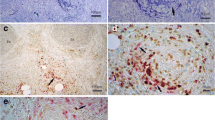Summary
In 42 human sural nerve biopsies degeneration of endoneurial cells was evaluated semiquantitatively at the electronmicroscopic level. These cells were of non-Schwannian origin since they were not surrounded by a basement membrane. Most of the degenerating cells resembled endoneurial fibroblasts: their remaining cytoplasmic processes were quite extensive, not finger-like as in macrophages, and their cytoplasm did not contain conspicuous lysosomes or phagolysosomes that would identify them as degenerating macrophages. Criteria for regarding these cells as degenerating were defects of the cytoplasmic surface membrane with extracellularly situated organelles. The ratio between normal and degenerating endoneurial cells in five different groups of peripheral neuropathies was compared to a group of normal controls. No degenerating endoncurial cells were found in the latter. The largest proportion of degenerating endoneurial cells was noted in patients with panarteritis nodosa (30% of the endoneurial cells evaluated). Between 9% and 18% of the evaluated endoneurial cells were seen degenerating in hereditary motor and sensory neuropathies, in neuropathies associated with IgG or IgM gammopathy, and in chronic demyelinating inflammatory polyradiculoneuropathy. These findings suggest that degeneration of endoneurial cells is a nonspecific sign of peripheral neuropathy occurring in various types of neuropathy, although vasculitis represents the most frequent cause. Thus, degeneration of endoneurial cells can be added to the growing list of changes that possibly indicate an inflammatory disorder, even during the intervening stage when apparent inflammatory cell infiltrates are lacking.
Similar content being viewed by others
References
Asbury AK, Cox SC, Baringer JR (1971) The significance of giant vacuolisation of endoneurial fibroblasts. Acta Neuropathol (Berl) 18:123–131
Bunge MB, Sanes JR, Wood PM, Tynan LB, Bates ML (1989) Perineurium originates from fibroblasts: demonstration in vitro with a retroviral marker. Science 243: 229–231
Conley FK, Rubinstein LJ, Spence AM (1976) Studies on experimental malignant nerve sheath tumors maintained in tissue and organ culture systems. II. Electron microscopy observations. Acta Neuropathol (Berl) 34:293–310
Dyck PJ, Conn DL, Okazaki H (1972) Necrotizing angiopathic neuropathy: three-dimensional morphology of fiber degeneration related to sites of occluded vessels. Mayo Clin Proc 47: 461–475
Dyck PJ, Hansen S, Karnes J, O'Brien P, Yasuda H, Windebank A, Zimmermann B (1985) Capillary number and percentage closed in human diabetic nerve. Proc Natl Acad Sci USA 52: 2513
Morris JH, Hudson AR, Weddel G (1972) A study of degeneration and regeneration in the divided rat sciatic nerve based on electron microscopy. IV. Changes in fascicular microtopography, perineurium and endoneurial fibroblasts. Z Zellforsch 124: 165–203
Norton WL, Nardo JM (1970) Vascular disease in progressive systemic sclerosis (scleroderma). Ann Intern Med 73: 317–324
Ohara S, Takahashi H, Ikuta F (1986) Specialized contacts of endoneurial fibroblasts with macrophages in Wallerian degeneration. J Anat 148: 77–85
Prineas JW, Ouvrier RA, Wright RG, Walsh JC, McLeod JG (1976) Giant axonal neuropathy: a generalized disorder of cytoplasmic microfilament formation. J Neuropathol Exp Neurol 35: 458–70
Röyttä M, Salonen V (1988) Long-term endoneurial changes after total axonotomy. Acta Neuropathol (Berl) 76: 35–45
Salonen V, Röyttä M, Peltonen J (1987) The effects of nerve transection on the endoneurial collagen fibril sheaths. Acta Neuropathol (Berl) 74: 13–21
Salonen V, Aho H, Röyttä M, Peltonen J (1988) Quantitation of Schwann cells and endoneurial fibroblast-like cells after experimental nerve trauma. Acta Neuropathol (Berl) 75: 331–336
Schröder JM (1986) Proliferation of epineurial capillaries and smooth muscle cells in angiopathic peripheral neuropathy. Acta Neuropathol (Berl) 72: 29–37
Schröder JM (1987) Pathomorphologie der peripheren Nerven. In: Neundörfer B, Schimrigk K, Soyka D (eds) Praktische Neurologie, 1st edn vol 2, Neundörfer B: Polyneuritiden und Polyneuropathien VCH, Weinheim, pp 11–104
Schröder JM, Seiffert KE (1970) Die Feinstruktur der neuromatösen Neurotisation von Nerventransplantaten. Virchows Arch [B] 5: 219–235
Thomas PK, Olsson Y (1984) Microscopic anatomy and function of the connective tissue components of peripheral nerve. In: Dyck PJ, Thomas PK, Lambert EH, Bunge R (eds) Peripheral neuropathy, 2nd edn, vol 2. Saunders, Philadelphia, pp 97–120
Thomas PK (1989) Invited review: focal nerve injury: guidance factors during axonal regeneration. Muscle Nerve 12: 796–802
Vital A, Vital C (1985) Polyarteritis, nodosa and peripheral neuropathy. Acta neuropathol (Berl) 67: 136–141
Vital C Vallat JM (1987) Ultrastructural study of the human diseased peripheral nerve, 2nd edn. Elsevier, New York Amsterdam, London, pp 95–98
Vital A, Vital C, Julien J, Baquey A, Steck AJ (1989) Polyneuropathy associated with IgM monoclonal gammopathy. Acta neuropathol 79: 160–167
Webster H deF, Schröder JM, Asbury AK, Adams RD (1967) The role of Schwann cells in the formation of “onion bulbs” found in various neuropathies. J Neuropathol Exp Neurol 26: 276–299
Author information
Authors and Affiliations
Rights and permissions
About this article
Cite this article
Grehl, H., Schröder, J.M. Significance of degenerating endoneurial cells in peripheral neuropathy. Acta Neuropathol 81, 680–685 (1991). https://doi.org/10.1007/BF00296380
Received:
Accepted:
Issue Date:
DOI: https://doi.org/10.1007/BF00296380




